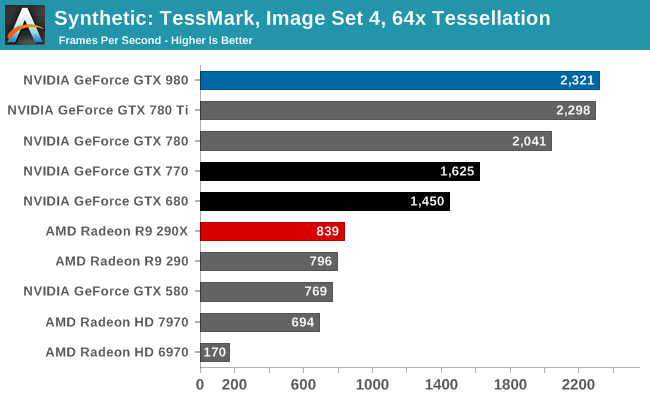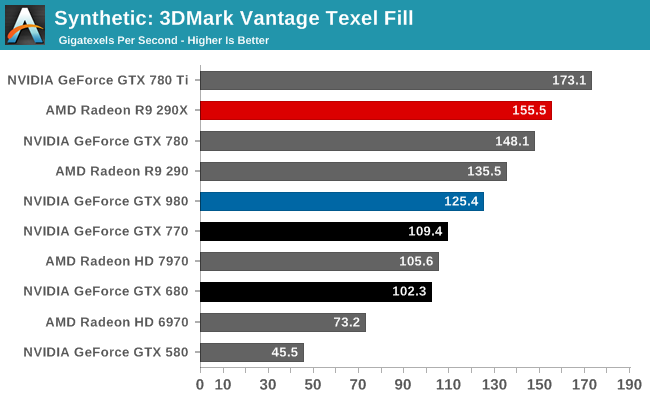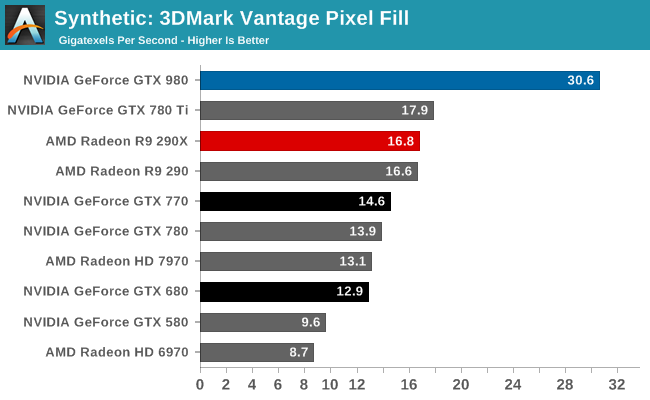The NVIDIA GeForce GTX 980 Review: Maxwell Mark 2
by Ryan Smith on September 18, 2014 10:30 PM ESTSynthetics
As always we’ll also take a quick look at synthetic performance. These tests mainly serve as a canary for finding important architectural changes, and with the exception of pixel throughput we are not expecting any major changes for GTX 980 and GM204.

GM204 is designed to have an ever-so-slightly higher triangle throughput rate than GK110 – 16 tris/clock versus 15 tris/clock, and sure enough the GTX 980 comes out on top in TessMark, slightly edging out the GTX 780 Ti. The difference is only very slight here, and though GM204 should be a bit more powerful than GK110 in practice it’s a dead heat.
Moving on, we have our 3DMark Vantage texture and pixel fillrate tests, which present our cards with massive amounts of texturing and color blending work. These aren’t results we suggest comparing across different vendors, but they’re good for tracking improvements and changes within a single product family.

Beginning with Maxwell NVIDIA reduced their texture-to-compute ratio from 12:1 to 16:1. As a result of this change Maxwell GPUs have fewer texture units than comparable Kepler GPUs. Compounding this effect is the fact that Maxwell CUDA cores are more efficient than Kepler CUDA cores, leading to NVIDIA placing fewer cores overall and further reducing the texture fill rate.
As a result the GTX 980 is not texture fillrate competitive with any of the GK110 cards. It is competitive with the GK104 cards, but only because these cards had the same number of texture units at 128. NVIDIA has told us that they believe this new ratio is a better fit for modern workloads, and judging from the performance we’re seeing elsewhere it would appear that NVIDIA is right.

On the other hand, thanks to NVIDIA’s newer 3rd generation delta color compression technology, our 3DMark pixel fillrate performance is through the roof. GTX 980 comes very close to doubling the throughput of our GK110 cards and more than doubles the throughput of the GK104 cards, reflecting the fact that it has 64 ROPs and more importantly has the available bandwidth to put them to good use.
This benchmark in a nutshell is why NVIDIA can deliver chart-topping performance despite having only 2/3rds the memory bandwidth of GTX 780 Ti. By improving their color compression to this point, NVIDIA can significantly reduce their memory bandwidth requirements Maxwell 2, allowing them to do more with less. In real games the result won’t be anywhere near this remarkable since this is a pure pixel fillrate test, but it goes to show that NVIDIA has been able to expand their effective memory bandwidth in concert with their ROP and shader performance improvements.










274 Comments
View All Comments
atlantico - Friday, September 19, 2014 - link
I'm sorry, but I couldn't care less about power efficiency on an enthusiast GPU unit. The 780Ti was a 250W card and that is a great card because it performs well. It delivers results.I have a desktop computer, a full ATX tower. Not a laptop. PSUs are cheap enough, it's even a question of that.
So please, stuff the power requirements of this GTX980. The fact is if it sucked 250W and was more powerful, then it would have been a better card.
A5 - Friday, September 19, 2014 - link
They'll be more than happy to sell you a $1000 GM210 Titan Black Ultra GTX, I'm sure.Fact is that enthusiast cards aren't really where they make their money anymore, and they're orienting their R&D accordingly.
Fallen Kell - Friday, September 19, 2014 - link
Exactly. Not only that, the "real" money is in getting the cards in OEM systems which sell hundreds of thousands of units. And those are very power and cooling specific.Antronman - Sunday, September 21, 2014 - link
Yep, yep, and yep again.For OEMs, the difference between spending 10 more or less dollars is huge.
More efficient cards means less power from the PSU. It's one of the reasons why GeForce cards are so much more popular in OEM systems.
I have to disagree with the statement about enthusiast cards not being of value to Nvidia.
Many people are of the opinion that Nvidia has always had better performance than AMD/ATI.
Tikcus9666 - Friday, September 19, 2014 - link
For desktop cards power consumption is meaningless to the 99%Price/Performance is much more important. if Card A uses 50w more under full load than card B, but performs around the same and is £50 cheaper to buy at 15 p per kwh cost for energy it would take 6666 hours of running to get your £50 back. Add to this if Card A produces more heat into the room, in winter months your heating system will use less energy, meanning it takes even longer to get your cash back.... tldr Wattage is only important in laptops and tablets and things that need batterys to run
jwcalla - Friday, September 19, 2014 - link
At least in this case it appears the power efficiency allows for a decent overclock. So you can get more performance and heat up your room at the same time.Of course I'm sure they're leaving some performance on the table for a refresh next year. Pascal is still a long way's off so they have to extend Maxwell's lifespan. Same deal as with Fermi and Kepler.
Icehawk - Friday, September 19, 2014 - link
When I built my mATX current box one criteria was that it be silent, or nearly so while still being a full power rig (i7 OC'd & 670), and the limitation really is GPU draw - thankfully NVs had dropped by the 6xx series enough I was able to use a fanless PSU and get my machine dead silent. I am glad I don't need a tower box that sounds like a jet anymore :)I would love to see them offer a high TDP, better cooled, option though for the uber users who won't care about costs, heat, sound and are just looking for the max performance to drive those 4k/surround setups.
Yojimbo - Friday, September 19, 2014 - link
I agree that power consumption in itself isn't so important to most consumer desktop users, as long as they don't require extra purchases to accommodate the cards. But since power consumption and noise seem to be directly related for GPUs, power efficiency is actually an important consideration for a fair number of consumer desktop users.RaistlinZ - Sunday, September 21, 2014 - link
Yeah, but they're still limited by the 250W spec. So the only way to give us more and more powerful GPU's while staying within 250W is to increase efficiency.kallogan - Friday, September 19, 2014 - link
dat beast